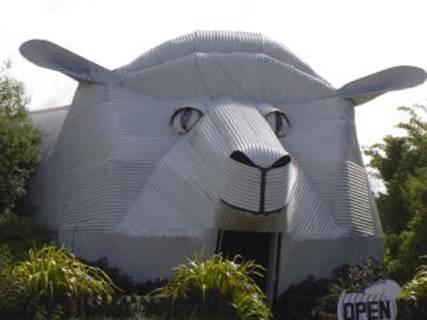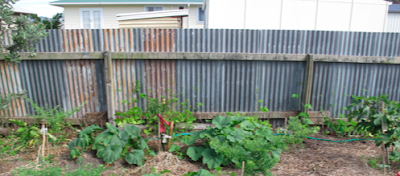
Sunday, January 30, 2011
February Workshops
Saturday, January 29, 2011
Beach Logging
Whole trees were washed up and stacked randomly amongst one another, leaving little room for my daily swim routine. So began my new career as a beach logger.

Nelson and I fire up our skidder and rumble down to the parking lot. Selecting only the finest wood for burning, we proceed to load the roof rack with logs of various sizes and up to eight meters long. Roping it all down, we headed for home.

The poor Subaru was riding low as we lumbered down the street, branches trailing close to the pavement. The four police cars we passed along the way seemed more concerned with catching hard criminals and drunks than busting us for doing a little beach clearing. Safely home, we unloaded without a scratch to the paint job. The wood now sits in a pile in the yard, awaiting the arrival of the multi-fuel stove and outdoor pizza oven.

-John the Intern
Editor's Note: John the Intern arrived to us, straight off a lobster boat in Maine, last Friday. He has been disappointed in the rainy New Zealand summer he's experienced thus far. But it beats the wintery thundersnows back home. He'll be in New Zealand until May, working with us and traveling to other sites. We've coerced him into writing some blog posts as part of his interning duties, so you can look forward to hearing more from him in the future.
Friday, January 28, 2011
Tears and Revolution

I'm fascinated that a number of powerful forces are using the high food prices to try to push genetically-modified seed into markets previously resisting GM food for any number of reasons. GM (also known as GE - genetically engineered) seed, they argue, is essential for feeding an ever-growing human population and prevent starvation and malnutrition. This, of course, would lead to more concentration of power and wealth while leaving the dispossessed even more dispossessed.
It is simultaneously maddening and tragic. I don't know whether to cry or revolt. In the end I do a little of each.
These are my tears…

and this is my revolution.


Keep growing, Estwing.
Tuesday, January 25, 2011
Video en Espanol
Sunday, January 23, 2011
Ups and Downs
But amidst all of that there is joy.
Like this heart-shaped potato.

And beautiful kids with sparklers.

And full workshops.

And ripening striped germans.

Some days it just takes a little more effort than other days to find the beauty in the world and remind ourselves that life is good.

-June Cleverer
Saturday, January 22, 2011
4 Dimensional Design: Multiple Functions

I won't try to improve on their excellent insights, but I would like to give an example of efficient/effective 4 dimensional permaculture design in action. (For those who have forgotten, TIME is the 4th dimension.) This is one of many 4 dimensional designs interacting on our property, but it illustrates the concept well.
Snails love overnighting within the agapanthus but because the caycuya grass has overgrown it is difficult and time-consuming to find them to feed to the ducklings. In this sense, the caycuya is seen as a 'liability' because it makes the process less efficient. Further down the page you'll see how we turn it into an 'asset'.
Now we could give our ducklings free range to find the snails themselves, but we have dogs in the neighborhood and no fencing out the front. So for the time-being we are offering escargot delivery services.
Gardeners and physicists know that the process of squatting down and then standing up takes lots of energy. Part of being a lazy gardener (explained in a future post) is designing strategies that don't require squatting down, and the other part is doing as much work as possible while your squatting before you stand up. With this in mind, as long as we're squatting down to hunt for snails we might as well pull all of the caycuya we can comfortably reach. The large snails are placed in a pail and the grass is piled beside it. (The small snails are set free to be harvested another day.)
When 12 to 15 snails have been harvested and all the caycuya within reach has been pulled, the job is done. until the nesting feeding time. The snails - liability to our gardens - are turned in an asset as duck food. The caycuya - also a liability to our gardens - is turned into an asset as a carbon neutral, hand-harvested, organic mulch. As a matter of fact, caycuya can be transformed from a liability to an asset within milliseconds and millimeters.
This is efficient/effective design because the snails are harvested on an as-needed basis. They stay fresh and grow best where they are. Why over-harvest and have to store them in a container?
The multi-tasking while squatting makes efficient use of the human component of the system. Since the caycuya poses no immediate threat, the job can be spread over a week or more taking only 5 minutes at a time.
And in the end, we'll have free food for our hungry trio, free eco-mulch for our garden, a tidier front section, and the stage is set for quick and easy snail harvest the next time around.
From a permaculture perspective, this illustrates the principle that every element of a system should serve multiple purposes. In 4 dimensional design, that element is the act of squatting down. As explained above, that single action serves multiple functions.
In my opinion, 4 dimensional design is not well understood or embraced by many permaculturists. It is something small that can make a big difference in a world of rising energy and food prices. What do you reckon?

Peace, Estwing
Thursday, January 20, 2011
Willow Update
You might remember that our Christmas Willow was a single branch that we had brought indoors and kept in a bucket of damp sand.
About two weeks after Christmas we brought the bucket and branch outside and removed all of the foliage. We were hoping this would encourage the tree to put its energy into creating roots and new buds, rather than trying to heal the older foliage.

We left the branch outside right near our tap, so we would remember to water it regularly. And two weeks later…

Success! We think. There appear to be healthy new buds forming on the branches. We haven't probed into the sand, but my guess is that if we did, we would find new root buds as well. We'll leave this little guy in the bucket until it has some more significant foliage and then will transplant it out to form the first part of our living-firewood-shelterbelt-fence.
The mother willow is doing even better than the cutting. In just four weeks the place where we did our major cutting has gone from this…

To this...

That's a lot of growth! Now we need to decide if we want to keep all of these new branches and have about one dozen small branches, or trim them, to encourage the tree to put its energy into just one or two. My gut tells me to trim the new branches back, and leave two, but I don't want to stress the tree too much. Any suggestions?

Tuesday, January 11, 2011
Solar Gain: Movie #2
Enjoy!
Friday, January 7, 2011
Eating Us out of House and Home

Well, we don't have a snail deficiency, we've got a baby duck surplus.

Our ducklings have just about doubled in size in the week that we've had them. Part of the goal of having ducks was to have a protein source that we did not have to buy food for, making small gains in self sufficiency. We thought we had tons of snails. In fact we were crunching them underfoot walking up our driveway after a late night out two weeks ago. But the recent cairina moschata population boost has put a bit of a strain on our small backyard eco-system. Our normal go-to spots for snails have been picked dry by the need to feed our ducklings' insatiable appetite.

So, after some internet research we have begun improvising some snail traps. Most people use these traps to lure snails away from their garden beds. We are hoping they lure snails out of their summer hiding places, and into an easy collection point.
Here is an example of the bricks and damp cardboard method.

And here is the toilet paper tube cluster method.

From past experience we know that the beer method works well, but we're a little afraid of the effects of intoxicating our wee babies just yet.
Ducks cannot subsist on snails alone, even when they are eating 20+ per day. So we are supplementing their diet with another resource we had in abundance, seedy grass. We were using grass to line the bottom of the duck's inside home, an unused bath tub, and found that they really liked eating the grain from the tops of the grass. Thanks to a preoccupied scyther our yard was a veritable sea of waving amber grain, or as the duckies see it, a sea of food waiting to be harvested.


This is pretty perfect since every grain of grass seed is one more future weed waiting to invade our garden beds.
So far the ducks are proving their worth by ridding us of two potential problems, and converting them both to fertilizer. As William McDonnough says "Waste = Food", or in this case, waste = ... more useful waste.
Have you found any good waste = food solutions lately? Pass them on.
Thursday, January 6, 2011
A Mid-Summer Night's Dream

Over the course of watching the first two seasons I can recognize patterns that often form when couples tackle these types of building projects – particularly those that are renovations. Inevitably, the project goes over budget and over time, the couple gets stressed out, and the episode ends with host Kevin McCloud chatting with the couple by candle light in a drafty room because the house does not have electricity or windows yet.
Let me make it perfectly clear that we (now) have electricity and windows, and that our design is anything but grand. (When Kev wants to start ‘Humble Designs’ we’ll be first in line.) When we bought this property we inherited an existing consent for a renovation that included a large deck, verandah, and walk-in closets. We eliminated these but added solar hot water and insulation. That’s the way we roll.
 Solar hot water and insulation are about as eco-thrifty as you can get. That is, you can save money and the planet simultaneously. Each one offers a return on investment greater than any term deposit in any bank. The point at which the savings from energy bills equals the purchase price is called the ‘payback period.’ After that, all of the additional savings are untaxed income: money in your pocket.
Solar hot water and insulation are about as eco-thrifty as you can get. That is, you can save money and the planet simultaneously. Each one offers a return on investment greater than any term deposit in any bank. The point at which the savings from energy bills equals the purchase price is called the ‘payback period.’ After that, all of the additional savings are untaxed income: money in your pocket.However, there is a caveat: you have to be able to afford them in the first place. If you can’t pay cash then you end up borrowing money, and the interest robs a part of your savings and extends the payback period. Although the US and NZ governments have schemes to help homeowners include energy efficiency measures, in most cases the result is more borrowing and more debt. (More on debt in a moment.)
In my opinion, the best approach governments could take would be providing zero-interest loans for insulation and solar hot water. These loans would act exactly like a cash purchase for the homeowner who could then repay the government through savings until the payback period is reached and then, as they say here, “Bob’s your uncle.”
While I have no idea why Kiwis use this phrase, I do have an uncle Bob. I do not, however, have a zero-interest loan. Therefore, I have dipped into my life savings to pay for insulation and solar hot water. This is an excellent investment because:
• Energy prices outpace the rate of inflation and there is every indication that this will only continue and even accelerate in the future. Any hedge against energy price rises is simply smart economically. The green benefits are a bonus.
• At the rate of quantitative easing (“printing money”) in the USA, my US dollars are becoming worth less and less everyday. Why leave them sitting in a bank losing value when they can be in my walls and on my roof adding value?
• New Zealand is not immune to debt either. This land of the long white cloud has significant debt issues on many levels that will come home to roost someday in the not-so-distant future. Whether that will look like Greece or Ireland I do not know. But something is bound to give.
• In a world that seems to be spinning out of control economically, environmentally and socially, it gives me peace of mind to have a tiny bit of control over a tiny property on a short street in a small city on a petite island in a big ocean.
We are not wealthy, but we have chosen to spend what money we do have on insulation and solar hot water for the reasons outlined above. We feel good about that decision, but it does not mean that we don’t stress out about going over budget and over time. After watching another uncompleted renovation on Grand Designs last night, I had terrible dreams that kept me tossing and turning in the summer heat.
I got up this morning, made myself a cup of coffee and started writing. I feel better now because I know we are doing this for all the right reasons. We are taking an abandoned house on a derelict section and turning into an urban homestead. We are sharing our story with anyone who wants to listen. And we are having fun doing it.

Peace, Estwing
Monday, January 3, 2011
First Harvest in the New House

And I think it did pretty well, considering we left it to fend for itself, and had to do a bit of an easter egg hunt to find it amongst the tall grass.

Here's to crops that grow themselves without any need for weeding or watering!

What should we toast with? Garlic bread dipped in pesto, perhaps?

-June Cleverer
R2 E2 (ie: 2nd edition)
Right on, Mr. 4! (funkypancake.com)
When I re-roofed my farmhouse in New Hampshire, I was in the vast minority of Americans who choose steel roofing over asphalt shingles.
But this post is not about new iron, it is about reusing old iron. For example, covering the unpainted/untreated wood from the renovation that we plan to burn this winter.
And creating temporary no maintenance edges to our potato patches while we put our efforts elsewhere.
And, although we won’t embrace this ourselves, reusing roofing iron as fencing has been embraced by neighbors all around us.
Eastern boundary
Northern boundary
Southern boundary
We are thinking of reusing roofing iron when we build our chicken/duck run and coop.
Hey Kiwis, any other suggestions?
Peace, Estwing

















